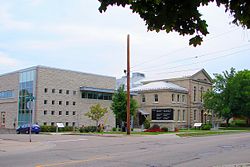Renfrew County Courthouse
 From Wikipedia - Reading time: 4 min
From Wikipedia - Reading time: 4 min
| Renfrew County Courthouse | |
|---|---|
 | |
 | |
| Alternative names | Pembroke Courthouse |
| General information | |
| Architectural style | Neoclassical |
| Location | Pembroke, Ontario, Canada |
| Address | 297 Pembroke Street East |
| Coordinates | 45°49′38.08″N 77°6′23.31″W / 45.8272444°N 77.1064750°W |
| Current tenants | Attorney General of Ontario |
| Construction started | 1862 |
| Completed | 1866 |
| Inaugurated | 1867 |
| Renovated | 2007 |
| Renovation cost | $23 million CAD |
| Owner | Ontario Realty Corporation |
| Technical details | |
| Floor area | 75,000 sq ft (7,000 m2) |
| Design and construction | |
| Architect(s) | Henry Horsey |
| Renovating team | |
| Renovating firm | NORR Limited Architects and Engineers |
| Awards and prizes | Certificate of Merit Office Building of the Year People's Choice Design Excellence |
The Renfrew County Courthouse is a designated heritage property and operational courthouse in Pembroke, Ontario, Canada.
Original building
[edit]
The neoclassical complex includes three buildings: the courthouse itself, a registry office and a small jail. The courthouse was built from 1862 to 1866, the registry office from 1862 to 1868, and the jail from 1864 to 1866.[1] As the Confederation of Canada occurred in 1867, the building is referred to as "Confederation-era". The original courthouse was designed by Henry Horsey.[2]
The registry office was built to the fire-prevention standards of the then-Chief Architect of Canada, Kivas Tully, who had an "obsession" with safety.[2]
The sandstone used in the original construction was quarried at nearby Morrison Island.[1]
The County Atlas of 1881 describes the courthouse as "one of the finest in Canada, combining the features of chaste beauty with simple elegance of construction in a degree possessed by few if any others in the country."[1] The exterior of the registry was re-bricked in the 1980s, and the heritage value suffered.[1]
Designation
[edit]The complex is protected under the Cultural Heritage Protocol Agreement the Ministry of Tourism, Culture & Recreation and the Management Board Secretariat (Ontario Realty Corporation).[3] It has not, however, been municipally designated under the Ontario Heritage Act.
2005 expansion
[edit]From 2005 to 2007, the building underwent significant heritage restoration. More than half of the original jail has been incorporated into the new facility.[1] The renovation was led by NORR Limited Architects and Engineers.[4]
The new construction used limestone from Guelph, Ontario. It added 48,276 square feet (4,485.0 m2) to the 18,729 of the preserved historic buildings.[1]
Awards
[edit]- In 2006, the American Academy of Architects' Academy of Architecture for Justice awarded the courthouse a Certificate of Merit.[1]
- In 2009, the courthouse was named "The Office Building of the Year" by the Building Owners and Managers Association of Ottawa.[5] The same association certified the courthouse as meeting its Building Environmental Standards for the 2008-09 fiscal year.
- The Ontario Association of Architecture awarded the courthouse its "People's Choice" and "Design Excellence" awards in 2009.[5]
Contemporary use
[edit]The renovated courthouse currently houses both a Superior Court of Justice and an Ontario Court of Justice, using its six courtrooms. It also has "two jury deliberation rooms, two settlement rooms, a victim/witness program office, Crown attorney offices and a secure vehicle drop-off point for in-custody individuals."[5]
References
[edit]- ^ a b c d e f g Young, Pamela (2008). The Renfrew County Courthouse. Ministry of the Attorney General.
- ^ a b Chodikoff, Ian (November 2007). "And Justice For All". Canadian Architect. Archived from the original on 2013-01-19. Retrieved 2009-07-20.
- ^ Ontario Heritage Properties Database. "Pembroke Jail MBS-ORC". Archived from the original on 2011-07-06. Retrieved 2008-07-05.
- ^ Dixon, Anthony. "Renfrew County Courthouse nominated for architecture award". The Daily Observer. Retrieved 2009-07-20.
- ^ a b c Chase, Sean (2009-07-18). "Pembroke Courthouse wins two major awards". The Daily Observer. Retrieved 2009-07-20.
 KSF
KSF